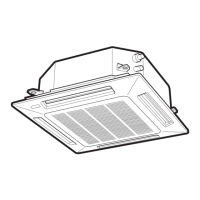Page
4. HOW TO INSTALL THE OUTDOOR UNIT ................56
4-1. Transporting
4-2. Installing the Outdoor Unit
5. ELECTRICAL WIRING ............................................. 57
5-1. General Precautions on Wiring
5-2. Recommended Wire Length and Wire Diameter
for Power Supply System
5-3. Wiring System Diagrams
6. HOW TO INSTALL THE REMOTE CONTROLLER
(OPTIONAL PART) .................................................... 61
6-1. When Using a Wall Box for Flush Mounting
6-2. Basic Wiring Diagram
6-3. Wiring System Diagram for Group Control
6-4. Wiring System Diagram for Multiple Remote
Control
6-5. Explanation of Alarm Messages
7. HOW TO INSTALL THE WEEKLY TIMER
(OPTIONAL CONTROLLER) ................................... 67
7-1. When Using a Wall Box for Flush Mounting
7-2. Wiring Diagram
7-3. Test Run Setting
7-4. Memory Back Up Function for Power Failure
Compensation
7-5. Display at Power ON
8. HOW TO PROCESS TUBING ................................. 71
8-1. Connecting Narrow Tubing Side
8-2. Connecting Wide Tubing Side
8-3. Connecting Tubing between Indoor and Outdoor
Units
8-4. Insulating the Refrigerant Tubing
8-5. Taping the Tubes
8-6. Finishing the Installation
9. AIR PURGING .......................................................... 75
10. HOW TO INSTALL THE CEILING PANEL ............... 78
■ 1-Way Air Discharge Semi-Concealed Type
(AS Type) .................................................................. 78
10-1. Installing the Ceiling Panel
10-2. How to Use the Stoppers
■ 2-Way Air Discharge Semi-Concealed Type
(S Type) ..................................................................... 79
10-3. Before Installing the Ceiling Panel
10-4. Installing the Ceiling Panel
10-5. When Removing the Ceiling Panel for Servicing
Page
■ 4-Way Air Discharge Semi-Concealed Type
(X Type) ..................................................................... 81
10-6. Before Installing the Ceiling Panel
10-7. Installing the Ceiling Panel
10-8. When Removing the Ceiling Panel for Servicing
10-9. Adjusting the Motor Flap
11. TEST RUN ................................................................ 84
11-1. Preparing for Test Run
11-2. PCB Setting & Test Run
11-3. Main Alarm Messages which Indicate Mis-Wiring
& Mis-Setting
11-4. Main Alarm Messages Indicating Unit Malfunction
11-5. Alarm Messages on the Outdoor PCB
12. CAUTION FOR PUMP DOWN.................................. 89

